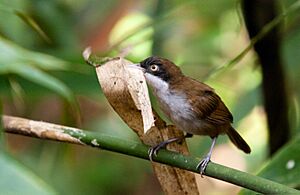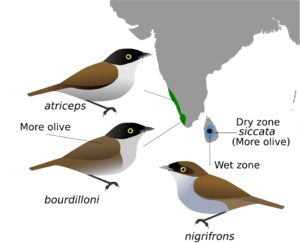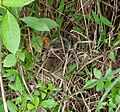Dark-fronted babbler facts for kids
Quick facts for kids Dark-fronted babbler |
|
|---|---|
 |
|
| Dumetia atriceps nigrifrons at Kanneliya Forest Reserve, Sri Lanka | |
| Conservation status | |
| Scientific classification | |
| Genus: |
Dumetia
|
| Species: |
atriceps
|
 |
|
| Synonyms | |
|
|
The dark-fronted babbler (Dumetia atriceps) is a small bird. It lives in the Western Ghats of India and the forests of Sri Lanka. These birds are mostly chestnut brown. They have a dark black cap on their heads. Their bellies are whitish, and their eyes are a pale yellow. Dark-fronted babblers often search for food in groups. They stay hidden in the thick plants found under trees in forests. They are quite noisy and make alarm calls if they feel scared.
Contents
About the Dark-Fronted Babbler
What Does Its Name Mean?
The dark-fronted babbler was first officially described in 1839. An English scientist named Thomas C. Jerdon gave it its first scientific name. The name Dumetia atriceps comes from Latin words. Dumetia means "thicket," which is a dense group of bushes. This fits because the bird likes to live in thick bushes. The word atriceps means "black-capped" or "black-headed." This describes the bird's dark head.
Different Types of Dark-Fronted Babblers
There are four different kinds, or subspecies, of the dark-fronted babbler:
- D. a. atriceps: Found in western to southern India.
- D. a. bourdilloni: Lives in southwest to southern India.
- D. a. siccata: Found in northern and eastern Sri Lanka.
- D. a. nigrifrons: Lives in southwest Sri Lanka.
What Does It Look Like?
The dark-fronted babbler is about 13 centimeters (about 5 inches) long. This includes its tail, which has a square tip. Its back and wings are brown, and its underside is white.
The babblers in India have black caps that cover most of their heads. But the babblers in Sri Lanka have a smaller dark mask, like a bandit's mask. All of them have bright pale yellow eyes that stand out.
The bourdilloni subspecies in southern India has a duller, sooty-black cap. Its belly is browner, and its upper parts are more olive green. The atriceps subspecies, found further north in India, has a very dark black cap.
In Sri Lanka, the siccata subspecies lives in lower areas. It has more olive colors on its upper body. The nigrifrons subspecies lives in wetter areas. It has more reddish-brown colors on its upper body.
How Does It Behave?
Where Do They Live and What Do They Eat?
Dark-fronted babblers do not fly very far. They usually stay in the same area their whole lives. They live in the thick undergrowth of forests. Sometimes, they live at the edge of forests where the plants are more open.
These birds often move around in small groups. They climb up plants to find food. If something scares them, they quickly drop down into the thick bushes below. Their main food is insects.
How Do They Communicate?
It can be hard to spot these birds because they like dense plants. But like other babblers, they are quite loud. You can often tell they are nearby by their special rattling churr alarm calls. They also often join groups of different bird species that are looking for food together.
Family Life
The dark-fronted babblers usually build their nests between May and July. They build their nests low down in a bush. The nest looks like a ball made of leaves, often bamboo leaves. It might even look like some dry leaves stuck in a bush, with an opening on the side.
A female babbler usually lays two eggs. Sometimes, these birds also build extra nests. These "dormitory nests" are not used for eggs. Instead, they are places where the birds might sleep together at night. These sleeping nests do not have soft lining inside.
Gallery




